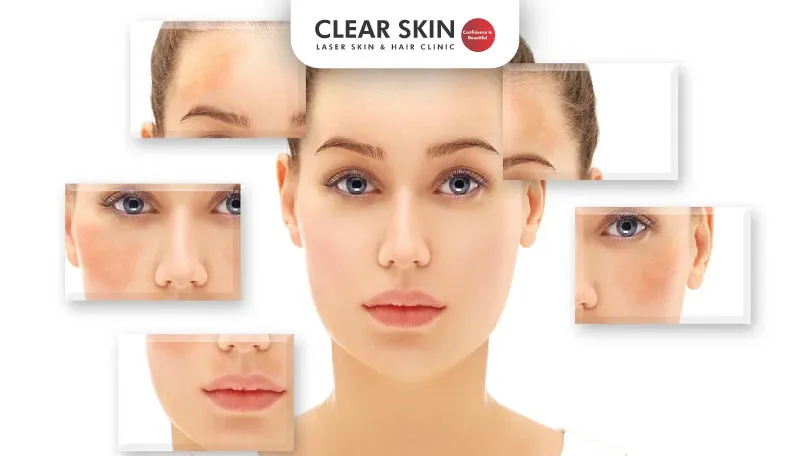Understanding the Different Types of Melasma
Reviewed By: Dr Dhananjay chavan
Updated on: 31st July, 2023

Melasma can be a frustrating condition to deal with, as the dark patches can be difficult to conceal and may affect your confidence and self-esteem. Understanding the different types of melasma and their specific characteristics is crucial in determining the most effective treatment option.
Are you frustrated with using various skincare products only to see little to no improvement in your skin’s appearance? If so, you may be dealing with melasma, a common skin condition affecting millions worldwide.
Melasma can be a frustrating condition to deal with, as the dark patches can be difficult to conceal and may affect your confidence and self-esteem. Understanding the different types of melasma and their specific characteristics is crucial in determining the most effective treatment option.
With the right approach, you can reduce the appearance of melasma and enjoy clearer, brighter, and more radiant skin. Let’s look at the melasma types and the treatment options available to help you achieve your skin goals.
Table Of Content
- Causes of Melasma
- Types of Melasma
- Melasma Treatment
- conclusion
Causes of Melasma
Melasma is a common skin condition that causes dark, irregularly shaped patches on the face, particularly on the cheeks, forehead, and upper lip. The exact cause of melasma is not fully understood, but it is believed to be related to a combination of factors, including genetics, hormonal changes, sun exposure, and certain medications.
Hormonal changes and fluctuations as seen with pregnancy, birth control, and hormone replacement therapy, can trigger melasma. This is why melasma is sometimes called the “mask of pregnancy.”
Exposure to the sun can also worsen melasma, as ultraviolet (UV) rays stimulate melanin production in the skin. Other factors contributing to melasma include certain medications (such as some antibiotics and anti-seizure drugs), genetics, and skin irritation.
Types of Melasma
There are three main melasma types: epidermal, dermal, and mixed.
Epidermal Melasma: Epidermal melasma is characterised by well-defined with well-defined borders and brown patches on the top layer of the skin (epidermis). It may appear clear under black light and usually responds well to treatment compared to other types of melasma because the excess pigment is closer to the skin’s surface.
Dermal Melasma: Dermal melasma is characterised by light brown or bluish-grey patches and a blurry border in the deeper skin layers (dermis). Unlike epidermal melasma, the patches do not appear differently under black light. Additionally, dermal melasma does not respond well to treatment and can be more challenging to manage than other types of melasma.
Mixed Melasma: Mixed melasma is one of the most common melasma types, characterised by patches that combine brown and bluish-grey colouration. The patches may have a mixed pattern under black light, indicating the presence of both epidermal and dermal melasma. Mixed melasma can be more challenging to treat than epidermal melasma, but it may still show some response to treatment.
Melasma Treatment
The treatment for melasma depends on the type and severity of the condition. Here are some common treatment options:
Topical Creams: Hydroquinone, tretinoin, and corticosteroids are common topical treatments used for melasma. Nowadays, newer depigmenting agents like kojic acid, arbutin, azelaic acid, glycolic acid etc are used to treat melasma. These creams work by reducing melanin production in the skin and lightening the dark patches.
Chemical Peels: Chemical peels involve the application of a solution to the skin, which causes the top layer of skin to peel off, revealing a fresh layer of skin. This treatment can effectively reduce melasma’s appearance, particularly epidermal melasma.
Laser Therapy: Laser therapy uses intense light energy to break up the excess pigment in the skin. This melasma treatment can be effective for all types of melasma, but it may take several sessions to see results.
Microdermabrasion: Microdermabrasion involves using a device to exfoliate the top layer of skin and promote the growth of new, healthier skin. It can effectively reduce melasma’s appearance, but multiple sessions may be necessary.
Sun Protection: Melasma can be worsened by exposure to the sun, so wearing sunscreen with an SPF of at least 30 and avoiding direct sunlight is essential in managing the condition.
Melasma can be a stubborn condition, and it may take several weeks or months of consistent treatment to see significant improvement. A dermatologist or melasma doctor in Pune can provide a personalised treatment plan based on the type and severity of the condition.
Do You Know?
Roughly 250 Patients Are Treated
Everyday By These Dermatologists
(You are one click away from flawless skin)
Meet Our Dermatologist!
Conclusion
Melasma is a common skin condition affecting many people, but with the right diagnosis and treatment plan. Understanding the different melasma types is crucial in determining the most effective treatment options.
If you’re looking for effective treatment for melasma, Clear Skin Clinics Pune can provide the personalised care and attention you need. With our commitment to using the latest technology and techniques, Clear Skin Clinics Pune can provide you with a comprehensive, safe and effective approach to treating melasma.
So don’t let melasma hold you back – book a consultation with Clear Skin Clinics Pune today and take the first step towards achieving clearer, more even-toned skin.
Further Reading
How to Avoid Acne in Monsoons?
Avoid acne in monsoons with a gentle skincare routine, diet tips, and hydration. Get expert advice to manage breakouts and keep your skin clear and healthy.
Does Makeup Cause Acne-Prone Skin?
Worried about breakouts from using makeup? Does makeup cause acne for you? Learn the safe ways to apply makeup for acne-prone skin.
Morning Skin Care Routine for Glowing Skin
Clear Skin Clinic, led by top dermatologists, shares the ideal morning skincare routine to help you achieve a radiant complexion naturally and effectively.
Monsoon Skin Care Tips for Radiant, Healthy Skin
Clear Skin Clinic, led by top dermatologists, shares the ideal morning skincare routine to help you achieve a radiant complexion naturally and effectively.
Have thoughts? Please let us know
We are committed not only to treating you, but also educating you.





